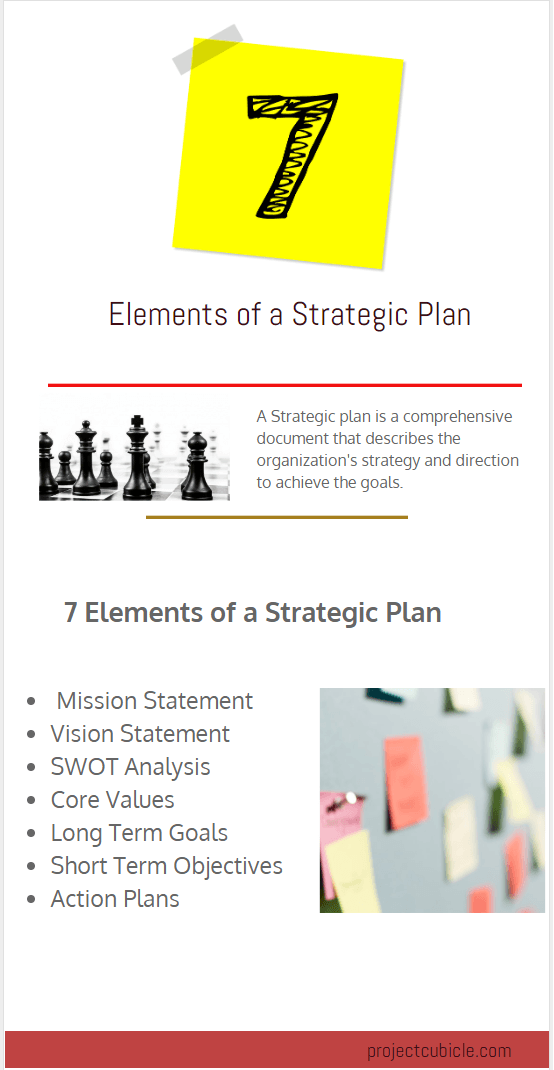What is the Purpose of a Strategic Plan?
In this article, we will talk about the basic elements of a strategic plan. A strategic plan is an archive that sets up the course of an association. It may be a solitary page or an extensive document, contingent upon the size and intricacy of the business and project.
Table of Contents
Most organizations can profit by having a strategic plan. The way toward building up a plan helps the director step back and inspect where they are, the place they need to go, and how to arrive. Without a complete plan, work can be completed but often lacks a sense of purpose and priority.
There are seven essential components of a strategic plan. While there can be significantly more remembered for the plan, these seven basic elements will assist you while creating a strategic plan.
What Should be Included in a Strategic Plan?
Mission Statement
The mission statement explains why a project or an organization exists, what is the goal of it and what kind of product is it going to provide. While a vision explains how you see your business to your clients and partners, a mission statement depicts what you do as of now. It frequently depicts what you do, for who, and how. In other words, the mission statement answers What, How, and Why questions. Concentrating on your mission every day should empower you to arrive at your vision. A mission statement could widen your decisions, as well as limit them.
Here is an example mission statement for a fast-food company;
“To create and serve delicious, healthy, organic hamburgers.”
Sometimes companies combine mission and vision in the same statement.
Vision Statement
A vision statement ought to be checked on consistently to guarantee it is as yet lined up with the manner in which you see your organization.
In other words, a vision statement depicts where the organization tries to be after accomplishing its mission. This statement uncovers the “where” of a business – however not exactly where the organization tries to be. Or maybe, a vision statement portrays where the organization needs a network, or the world, to be because of the organization’s administrations.
SWOT Analysis
Core Values
In a strategic plan, core values describe a person’s or an organization’s priorities, beliefs, and behaviors. They are the convictions you have that will empower you to accomplish your vision and mission. They are the base of what your organization stands for.
Core values are essential to structure the vision of your business that you present to the world outside of your business. They characterize what your business accepts and how you need your business reverberating with and engaging workers and the outer world. The core values ought to be so coordinated with your workers and their conviction frameworks and activities that customers, clients, and merchants see the values in real life.
Here is an example of core value for a fast-food company;
- Creating a culture to satisfy and delight customers.
- Promoting happiness and growth.
- Delivering our best.
- Practicing fruitful partnerships with our suppliers
Long Term Goals
Long-term goals cover an important place in a strategic plan. Long-term goals are articulations that drill down a level beneath the vision and portray how you intend to accomplish it. This arrangement of goals for the most part begins three years out and reaches out to around five years into the future, straightforwardly lining up with the vision and mission statements.
Long-term goals are the achievements that an organization sets to manage activities toward its broad targets. A few instances of long-term goals could be for an organization to strengthen its position on the local market, expanding benefits, or growing its operations.
Recommended Article: Smart Goals Examples
Short Term Objectives
Unlike goals, objectives are short-term targets set by the organization. Objectives should be SMART (Specific, Measurable, Achievable, Realistic, and Time-Based) to reach your goals.
Once you’ve defined your long-term goals, break them down into smaller short-term objectives to define the actions to be taken in the near future.
Recommended Article: Smart Goals Objectives
Action Plans
Every objective ought to have an arrangement that subtleties how it will be accomplished. The amount of detail relies upon the measure of adaptability you need your directors and group to have. The more detail there is, the less adaptability those that tail it has. It is obvious that without a plan a vision can be only a dream.
What Do You Think About the Strategic Plan?
No matter what type of business you are running, you need a strategic plan to grow and survive in today’s highly competitive economic environment. A Strategic Plan is a comprehensive document that describes the organization’s strategy and direction to achieve the goals. What do you think about the purpose and the basic elements of a strategic plan? Share with us through the comments section.
Further Reading

Margaret Conte has been working as a consultany for over 15 years. In this time, she has worked in a variety of project management methodologies (waterfall/scrum/agile) and has been a strategic Project Manager, Coordinator, Facilitator and Scrum Master. She is the co-founder of Development Fast Academy











As the conclusion says, no matter what kind of business you are running, you need a strategy to be able to keep running the business.
so many thing is important for success but if you don’t have a good designed Strategic Plan you have% 1 chance.
Strategic planning can benefit your organization’s vision, execution, and progress toward goals ! 🙂